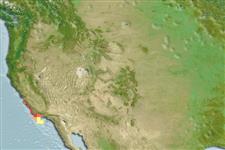Classification / Names
Common names from other countries
Main reference
Size / Weight / Age
Max length : 28.8 cm SL male/unsexed; (Ref. 26664)
Environment
Marine; demersal; depth range 1 - 21 m (Ref. 26664)
Climate / Range
Subtropical, preferred ?
Distribution
Short description
Dorsal
spines
(total): 50 - 51;
Anal
spines: 2;
Anal
soft rays: 31 - 33;
Vertebrae: 53 - 55. Tubule processes of the lateral line canals are inclined irregularly, postdorsally, and postventrally; unbanded pectorals; branchiostegal membrane separate from isthmus.
IUCN Red List Status (Ref. 115185)
Threat to humans
Harmless
Human uses
More information
Common namesSynonymsMetabolismPredatorsEcotoxicologyReproductionMaturitySpawningFecundityEggsEgg development
Age/SizeGrowthLength-weightLength-lengthLength-frequenciesMorphometricsMorphologyLarvaeLarval dynamicsRecruitmentAbundance
ReferencesAquacultureAquaculture profileStrainsGeneticsAllele frequenciesHeritabilityDiseasesProcessingMass conversion
Tools
Special reports
Download XML
Internet sources
Estimates of some properties based on models
Phylogenetic diversity index
PD50 = 0.6250 many relatives (e.g. carps) 0.5 - 2.0 few relatives (e.g. lungfishes)
Trophic Level
3.4 ±0.5 se; Based on size and trophs of closest relatives
Resilience
Low, minimum population doubling time 4.5 - 14 years (Preliminary K or Fecundity.)
Vulnerability
Moderate to high vulnerability (52 of 100)
Price category
